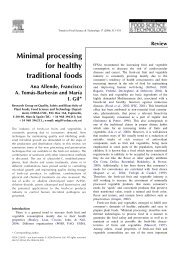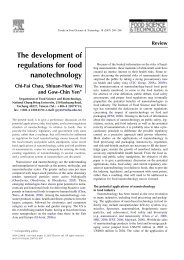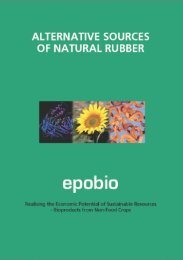production of wax esters in crambe
production of wax esters in crambe
production of wax esters in crambe
You also want an ePaper? Increase the reach of your titles
YUMPU automatically turns print PDFs into web optimized ePapers that Google loves.
The above issues can be solved by us<strong>in</strong>g a marker-free selection strategy. Several<br />
alternatives exist such as the Cre/Lox system (Corneille et al., 2001), us<strong>in</strong>g a<br />
transiently co<strong>in</strong>tegrated selection gene (Klaus et al., 2004) or comb<strong>in</strong><strong>in</strong>g an<br />
<strong>in</strong>ducible site-specific recomb<strong>in</strong>ase for the precise elim<strong>in</strong>ation <strong>of</strong> undesired,<br />
<strong>in</strong>troduced DNA sequences with a bifunctional selectable marker gene used for the<br />
<strong>in</strong>itial positive selection <strong>of</strong> transgenic tissue and subsequent negative selection for<br />
fully marker-free plants (Schaart et al., 2004).<br />
4.2.2 Risk mitigation <strong>of</strong> GM<br />
To m<strong>in</strong>imise risks <strong>in</strong> us<strong>in</strong>g a genetic eng<strong>in</strong>eer<strong>in</strong>g strategy for the <strong>production</strong> <strong>of</strong> <strong>wax</strong><br />
<strong>esters</strong>, this report suggests certa<strong>in</strong> steps.<br />
To reduce the risks <strong>of</strong> mix<strong>in</strong>g an <strong>in</strong>dustrial feedstock <strong>in</strong>to the food cha<strong>in</strong>, establish<strong>in</strong>g<br />
this <strong>production</strong> <strong>in</strong> a non-food crop is regarded as the preferred strategy. It is not<br />
expected that Crambe can cross easily with other related species. Inter-specific<br />
crosses between the most closely related species C. hispanica and C. abyss<strong>in</strong>ica<br />
gave nearly sterile <strong>of</strong>fspr<strong>in</strong>g, associated with imbalances <strong>in</strong> chromosome number<br />
(Wang and Peng, 1998). Outcross<strong>in</strong>g <strong>of</strong> a GM Crambe with wild Crambe species<br />
and/or other crucifereae species is therefore unlikely. However, when grow<strong>in</strong>g the<br />
GM Crambe it is recommended to use the same cultivation practices as when<br />
grow<strong>in</strong>g GM rapeseed, e.g. non-GM barrier crop, m<strong>in</strong>imum distance to nearby non-<br />
GM Crambe field and prevention <strong>of</strong> volunteer GM-Crambe by tillage and/or<br />
herbicide treatment the follow<strong>in</strong>g season should be utilised to help ensure identity<br />
preservation <strong>of</strong> the crop.<br />
Consider<strong>in</strong>g the types <strong>of</strong> <strong>wax</strong> <strong>esters</strong> and fatty acids that will be produced <strong>in</strong> the GM<br />
Crambe, i.e. novel branched fatty acids and hydroxyl fatty acids <strong>in</strong> <strong>wax</strong>es, it should<br />
be noted that the same or similar compound already exists <strong>in</strong> nature. For example<br />
hydroxy fatty acids are produced <strong>in</strong> seed oils <strong>of</strong> castor bean and Lesquerella sp.<br />
(van de Loo et al., 1995; Broun, et al., 1998) while <strong>wax</strong> <strong>esters</strong> conta<strong>in</strong><strong>in</strong>g branched<br />
fatty acids are found <strong>in</strong> the fluids that certa<strong>in</strong> birds use to impregnate their feathers<br />
(Kolattukudy et al., 1985).<br />
26









